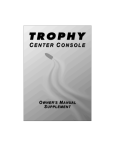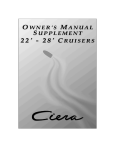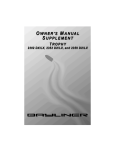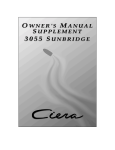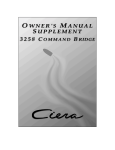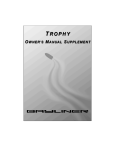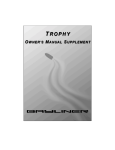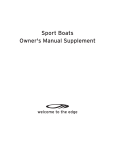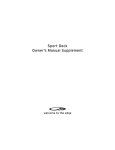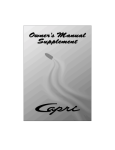Download Bayliner Rendezvous Specifications
Transcript
Hull Identification Number: The Hull Identification Number (HIN) is located on the starboard side of the transom. Be sure to record the HIN in the space provided above and always refer to the HIN for all correspondence or orders. TYPICAL HIN LOCATION STARBOARD TRANSOM BOARDING LADDER © Bayliner Technical Publications. All rights reserved. No part of this publication may be reproduced, stored in any retrieval system, or transmitted in any form by any means, electronic, mechanical, photocopying, recording or otherwise, without prior written permission of Bayliner. Printed in the United States of America. Proprietary Rights This document discloses subject matter in which Bayliner has proprietary rights. The information and design disclosed herein were originated by and are the property of Bayliner. Neither receipt nor possession thereof confers or transfers any right to reproduce, copy, alter or disclose the document or any part thereof, any information contained therein, or to construct boats or any item from it, except by written permission from or written agreement with Bayliner. This document is to be returned upon request to Bayliner. General Notes The material in this document is for information only and is subject to change without notice. While reasonable efforts have been made in the preparation of this document to assure its accuracy, Bayliner assumes no liability resulting from errors or omissions in this document, or from the use of information contained herein. Due to our commitment to product improvement, Bayliner reserves the right to make changes in the product design, specifications, and equipment at any time without notice or obligation. Illustrations and/or photos may show optional equipment. All Bayliner products meet or exceed USCG (Unites States Coast Guard) and/or NMMA (National Marine Manufacturer’s Association) construction standards. Manufactured with 1,1,1 Trichloroethane, a substance which harms public health and environment during the manufacturing process by destroying ozone in the upper atmosphere. CONTENTS CHAPTER 1: WELCOME ABOARD! Dealer Service 1 Boating Experience 1 Structural Limitations 1 Engines & Accessories Guidelines 2 Safety Standards 2 Qualified Maintenance 2 Special Care For Moored Boats 3 Hazard Boxes & Symbols 3 CHAPTER 2: PRODUCT SPECIFICATIONS 2109 4 2159 4 2459 4 2659 4 CHAPTER 3: COMPONENTS / SYSTEMS Electrical System 5 DC Electrical System 6 Navigation Lights 6 AM/FM Cassette Stereo 7 Propulsion 7 Bilge Systems 8 Fuel System 9 10 Freshwater Systems 11 Live Well System (Option) 11 Portable Head 11 Deck Equipment 12 Canvas Installation CHAPTER 4: SYSTEM DIAGRAMS 14 2109 17 2159 21 2459 25 2659 CONTENTS CHAPTER 5: WIRING SCHEMATICS 29 Engine/Accessory Harnesses 33 Deck Harnesses 34 Bilge Harness 34 Trolling Motor Harness 34 Water Pump Harness 35 Fuse Block Harness APPENDIX A: LIMITED WARRANTY 36 What Is Not Covered 36 Other Limitations 36 Your Obligation This Owner’s Manual Supplement contains specific information about the following Rendezvous boats: 2109, 2159, 2459, 2659 1 CHAPTER 1: WELCOME ABOARD! This owner’s manual supplement provides specific information about your boat that is not covered in the owner’s manual. Please study the owner’s manual and this supplement carefully, paying particular attention to Appendix A: LIMITED WARRANTY. Keep the owner’s manual and this supplement on your boat in a secure, yet readily available place. Dealer Service Make sure you receive a full explanation of all systems from the selling dealer before taking delivery of your boat. Your selling dealer is your key to service. If you experience any problems with your new boat, immediately contact the selling dealer. If for any reason your selling dealer is unable to help, you can call us direct on our customer service hotline: 360-435-8957 or send us a FAX: 360-403-4235. Boating Experience If this is your first boat or if you are changing to a type of boat you are not familiar with, for your own comfort and safety, please ensure that you obtain handling and operating experience before assuming command of the boat. We strongly recommend that you take one of the boating safety classes offered by the U.S. Power Squadrons or the U.S. Coast Guard Auxiliary. For more course information, including dates and locations of upcoming classes, contact the organizations directly: • U.S. Power Squadrons: 1-888-FOR-USPS (1-888-367-8777) or on the Internet at: http://www.usps.org • U.S. Coast Guard Auxiliary: 1-800-368-5647 or on the Internet at: http://www.cgaux.org Outside the United States, your selling dealer, national sailing federation or local yacht club can advise you of local sea schools or competent instructors. ! WA RNIN G! CONTROL HAZARD! A qualified operator must be in control of the boat at all times. DO NOT operate your boat while under the influence of alcohol or drugs. Structural Limitations The transom platform and bow platform are designed to be lightweight for proper boat balance. The load limit for these platforms is 30 pounds per square foot, evenly distributed. Rendezvous Owner’s Manual Supplement 2 CHAPTER 1: WELCOME ABOARD! Engines & Accessories Guidelines Your boat’s engines and accessories were selected to provide optimum performance and service. Installing different engines or accessories may cause unwanted handling characteristics. Should you choose to install different engines or add accessories that will affect the boat’s running trim, have an experienced marine technician perform a safety inspection and handling test before operating your boat again. Please be advised that certain modifications to your boat can result in cancellation of your limited warranty protection. Always check with your dealer before making any modifications to your boat. The engines and accessories installed on your boat come with their own operation and maintenance manuals. We strongly urge you to read and understand these manuals before operating the engines and accessories. Safety Standards Your boat’s mechanical and electrical systems were designed to meet safety standards in effect at the time it was built. Some of these standards were mandated by law; all of them were designed to insure your safety, and the safety of other people, vessels and property. In addition to this supplement, please read the owner’s manual and all accessory instruction sheets included in your owner’s packet for important safety standards and hazard information. ! DAN GEDANGER R! PERSONAL SAFETY HAZARD! DO NOT allow anyone to ride on parts of the boat not designated for such use. Sitting on seat backs, lounging on the forward deck, bow riding, gunwale riding or occupying the transom platform while underway is especially hazardous and WILL cause personal injury or death. Qualified Maintenance Failure to maintain your boat’s systems as designed could violate the laws in your jurisdiction and could expose you and other people to the danger of bodily injury or accidental death. We recommend that you follow all maintenance instructions provided in the owner’s manual, this supplement, the engine owner’s manual as well as all accessory instruction sheets and manuals included in your boat’s owner’s packet. ! WA RNIN G! To maintain the integrity and safety of your boat, only qualified personnel should perform maintenance on, or in any way modify: The steering system, propulsion system, engine control system, fuel system, environmental control system, electrical system or navigational system. Rendezvous Owner’s Manual Supplement CHAPTER 1: WELCOME ABOARD! 3 Special Care For Moored Boats If moored in saltwater or fresh water, your boat will collect marine growth on its hull bottom. This will detract from the boat’s beauty, greatly affect its performance and may damage the gelcoat. There are two methods of slowing marine growth: • Periodically haul the boat out of the water and scrub the hull bottom with a bristle brush and a solution of soap and water. • Paint the hull below the waterline with a good grade of anti-fouling paint. NOTIC E To help seal the hull bottom and reduce the possibility of gelcoat blistering on moored boats, we recommend the application of an epoxy barrier coating, such as Interlux, Interprotect 2000E/2001E. The barrier coating should be covered with several coats of anti-fouling paint. Many states regulate the chemical content of bottom paints in order to meet environmental standards. Check with your local dealer about recommended bottom paints, and about the laws in effect in your area. Hazard Boxes & Symbols The hazard boxes and symbols shown below are used throughout this supplement to call attention to potentially dangerous situations which could lead to either personal injury, death or product damage. We urge you to read all hazard warnings carefully and follow all safety recommendations. HOT HAZARD! EXPLOSION HAZARD! ELECTRICAL HAZARD! ! OPEN FLAME HAZARD! PERSONAL INJURY & FALLING HAZARD! ROTATING PROPELLER HAZARD! DAN GEDANGER R! This box alerts you to immediate hazards which WILL cause severe personal injury or death if the warning is ignored. ! WA RNIN G! This box alerts you to hazards or unsafe practices which COULD result in severe personal injury or death if the warning is ignored. ! CAUTIO N! This box alerts you to hazards or unsafe practices which COULD result in minor personal injury or cause product or property damage if the warning is ignored. NOTIC E This box calls attention to installation, operation or maintenance information, which is important to proper operation but is not hazard related. Rendezvous Owner’s Manual Supplement 4 CHAPTER 2: PRODUCT SPECIFICATIONS 2109 Length overall - 21' 3" Beam - 8' 3" Deadrise - 16 degrees Weight (standard engine) - 3,1458 lb. Draft hull - 1' 3" Draft max - 2' 8" Bridge clearance - 4' 2" Fuel capacity - 45 gal. Freshwater capacity (option) - 19 gal. 2159 Length overall - 21' 3" Beam - 8' 3" Deadrise - 16 degrees Weight - 3,750 lb. Draft hull - 1' 4" Draft max - 2' 8" Bridge clearance - 4' 1" Fuel capacity - 45 gal. Freshwater capacity (option) - 19 gal. 2459 Length overall - 24' 0" Beam - 8' 3" Deadrise - 17 degrees Weight - 4,333 lb. Draft hull - 1' 4" Draft max - 2' 9" Bridge clearance - 4' 3" Fuel capacity - 65 gal. Freshwater capacity (option) - 19 gal. 2659 Length overall - 26' 5" Beam - 8' 5" Weight - 4,898 lb. Draft hull - 1' 1" Draft max - 2' 6" Bridge clearance - 4' 5" Fuel capacity - 57 gal. Freshwater capacity - 13 gal. Rendezvous Owner’s Manual Supplement 5 CHAPTER 3: COMPONENTS / SYSTEMS Electrical System We strongly recommend that you thoroughly read and understand the electrical sections of the owner’s manual and all accessory manuals included in your boat’s owner’s packet. Wiring schematics are provided in chapter 5 of this supplement. ! DAN GEDANGER R! FIRE, SHOCK & EXPLOSION HAZARD! • DO NOT modify the electrical systems or relevant drawings. Only qualified personnel should install batteries and/or perform maintenance on the electrical system. • To minimize the risks of fire and explosion, NEVER install knife switches or other arcing devices in the fuel compartments. NEVER substitute automotive parts for marine parts. Electrical, ignition and fuel system parts were designed and manufactured to comply with rules and regulations that minimize risks of fire and explosion. ! WA RNIN G! FIRE & EXPLOSION HAZARD! • Fuel fumes are heavier than air and will collect in the bilge areas where they can be accidently ignited. Visually and by smell (sniff test), check the engine and fuel compartments for fumes or accumulation of fuel. Always operate the bilge blowers for at least four minutes prior to engine starting, electrical system maintenance or activation of electrical devices. • To minimize the danger of fire and explosion, DO NOT expose batteries to open flame or sparks. • DO NOT smoke anywhere near the batteries. ! CAUTIO N! SHOCK & ELECTRICAL SYSTEM DAMAGE HAZARD! • NEVER disconnect the battery cables while the engine is running since damage may occur to your boat’s electrical system components. • The battery charging system (alternator) installed on your boat are designed to charge conventional lead-acid batteries. Before installing gel-cell or other new technology batteries, consult with the battery manufacturer about charging system requirements. NOTIC E Electrical connections are prone to corrosion. To reduce electrical problems caused by corrosion, keep all electrical connections clean and apply a spray-on protectant that is designed to protect connections from corrosion. Rendezvous Owner’s Manual Supplement 6 CHAPTER 3: COMPONENTS / SYSTEMS DC Electrical System All Rendezvous models are equipped with a 12 volt DC (direct current) system. Fuses and Circuit Breakers • Fuses and circuit breakers for engines and main accessory power are located on the dash. • Electronics power is provided at the helm. • Some equipment may have secondary fuse protection at the unit. Battery Maintenance Corroded battery terminals can be cleaned with baking soda and water. After cleaning the terminals, be sure to coat them with a light film of battery terminal lubricant and tighten all battery connections. Depth Finder (Option) Your boat may feature an optional depth finder (depth sounder) at the helm. The depth finder provides you with measurements of water depth beneath the boat. Be sure to read the depth finder owner’s manual for detailed operating instructions. ! WA RNIN G! • DO NOT use the depth finder as a navigational aid to prevent collision, grounding, boat damage or personal injury. • When the boat is moving, submerged objects will not be seen until they are already under the boat. Bottom depths may change too quickly to allow time for the boat operator to react. If you suspect shallow water or submerged objects, operate the boat at very slow speeds. Navigation Lights We strongly recommend that you understand navigation light usage by reading the navigation light section of the owner’s manual. The navigation lights are of top quality, but you should be aware that failure may periodically occur for a variety of reasons: • • • • There may be a blown fuse - replace the fuse in the switch panel. The bulb may be burned out - carry spare bulbs for replacement. A wire may be damaged or may have come loose - repair as required. The bulb base may be corroded - clean the base and coat it with non-conductive electrical lubricant. ! CAUTIO N! Avoid the storage of gear where it would block navigation lights from view. Rendezvous Owner’s Manual Supplement CHAPTER 3: COMPONENTS / SYSTEMS 7 AM/FM Cassette Stereo Your boat comes standard-equipped with an AM/FM cassette stereo. The stereo comes with its own instruction manual that explains its operating procedures in detail. NOTIC E AM radio reception may be impaired in areas where reception is limited or anytime the engines are running. Propulsion TYPICAL BILGE BLOWER SYSTEMS Engine The owner’s packet contains detailed engine operation and maintenance manuals. Be sure to read and understand these manuals before operating or performing maintenance to your boat’s engine. COLLECTOR (TYPICAL) BLOWER LOUVER (TYPICAL) Engine Compartment Ventilation System Bilge blowers are installed on all inboard boats to remove fumes from the engine compartment. (26 59 To ensure fresh air circulation, operate the bilge blowers in the following situations: VENT HOSE (TYPICAL) GD ) TRANSOM VENT BLOWER VENT HOSE • At least four (4) minutes prior to starting the engine and during engine starting. • Anytime your boat is operating below cruising speed. 45 (2 ! 9 B) G WA RNIN G! EXPLOSION HAZARD! • Operation of the blower system is NOT a guarantee that explosive fumes have been removed. If you smell fuel, DO NOT start the engines. If the engines are already running, immediately shut off the engines and all electrical accessories and investigate immediately. • DO NOT obstruct or modify the ventilation system. Rendezvous Owner’s Manual Supplement 8 CHAPTER 3: COMPONENTS / SYSTEMS Bilge Systems Bilge Pumps • Your boat is equipped with impeller-type bilge pumps, which are used to pump water out of the bilge. • Bilge pumps are controlled by automatic bilge pump float switches (autofloat switches) and/or switches at the helm. • Automatic bilge pumps are wired directly to the battery so they will function even when the boat is completely shut down and left unattended. NOTIC E Discharge of oil, oil waste or fuel into navigable waters is prohibited by law. Violators are subject to legal action by the local authorities. Bilge Pump Testing Bilge pumps should be tested often to verify they are working properly. To test a bilge pump, activate the dash-mounted switch and verify that water in the bilge is being pumped overboard. If bilge water is present and the pump motor is running but NOT pumping, inspect the discharge hose for a kink or collapsed area. If no problems are found, check the bilge pump housing for clogging debris as follows: To check for clogging debris: 1. Remove the power cartridge: a. Lift the tab while rotating the fins counterclockwise. b. Lift out the power cartridge. c. Clear debris from the outer housing. 2. Reinstall the power cartridge: a. Make sure the “O” ring is properly seated. b. Coat the “O” ring with a light film of vegetable or mineral oil. c. Align the two cams on either side of the power cartridge with the two slots on the outer housing and press the power cartridge into the housing while twisting clockwise. 3. Ensure proper reinstallation by attempting to twist the fins counterclockwise without lifting the tab. The cartridge should stay in place. FIN TAB TYPICAL BILGE PUMP COMPONENTS LIGHT FILM OF OIL CAM (TYPICAL) “O” RING POWER CARTRIDGE OUTER HOUSING SLOT (TYPICAL) Autofloat Switches Automatic bilge pumps use electromagnetic float (autofloat) switches to automatically activate the pump whenever water accumulates above a preset level in the bilge. One autofloat switch is mounted next to the bilge pump it activates, and is wired directly to the battery so it will function even when the boat is completely shut down and left unattended. Rendezvous Owner’s Manual Supplement CHAPTER 3: COMPONENTS / SYSTEMS 9 Autofloat switches should be tested often for proper operation as follows: 1. 2. Push the float switch test button UP to activate the bilge pump. If the pump does NOT turn on, check the inline fuse. If the fuse is good but the switch doesn’t work, it may indicate a bad switch or possibly a low battery. Push the test button all the way DOWN to return the float switch back into the auto mode. ! FLOAT SWITCH TESTING FLOAT SWITCH TEST BUTTON SWITCH UP - AUTO MODE; BILGE PUMP SHOULD TURN OFF SWITCH DOWN - AUTO MODE; BILGE PUMP SHOULD TURN OFF CAUTIO N! When the float switch test is completed, you MUST push the test button all the way DOWN to return the switch back into auto mode! Fuel System Carefully read the fuel system sections of the owner’s manual and the engine operation manual. NOTIC E Discharge of fuel into navigable waters is prohibited by law. Violators are subject to legal action by the local authorities. ! WA RNIN G! FIRE, EXPLOSION AND OPEN FLAME HAZARD! • It is very important that the fuel system be inspected thoroughly the first time it is filled and at each subsequent filling. • The fueling instructions in the owner’s manual and the fuel grade recommendations in the engine operation manual must be followed. ! CAUTIO N! Avoid the storage or handling of gear near the fuel lines, fittings and tank. Fuel Fill Location The fuel fill receptacle is located on the starboard aft deck of your boat and is labeled “GAS”. If you experience difficulty when filling the fuel tank, check to see that the fuel fill and vent lines are free of obstructions and kinks. Rendezvous Owner’s Manual Supplement 10 CHAPTER 3: COMPONENTS / SYSTEMS Fuel Quality TYPICAL FUEL SYSTEM ROUTING • Refer to your engine manual for fuel TO FUEL TO FUEL VENT FILL FITTING grade recommendations. FUEL VENT HOSE • Make sure your fuel suppliers are FUEL FILL reputable and can be relied upon HOSE to furnish clean, high quality fuel. Once you have found such suppliers, keep your tank as full as possible with their fuel (allowing for expansion due to temperature variations). Then, if you are forced to add a potentially poor FUEL FEED quality fuel supply to the tank, HOSE the portion of poor quality fuel will be minimized. • Consult your selling dealer or local marina about recommended fuel additives that help prevent fungus or buildup inside the fuel tank. Anti-siphon Valves Your boat may feature anti-siphon valves, which are an integral part of the fuel line barb fitting on gas fuel tanks. Anti-siphon valves are spring loaded and are opened by fuel pump vacuum. In the unlikely event of a fuel line rupturing, the anti-siphon valve is designed to prevent the siphoning of fuel from the tank. ! WA RNIN G! FIRE/EXPLOSION HAZARD! If an engine problem is caused by fuel starvation, check the anti-siphon valve. If the valve is stuck or clogged, shut down the engine and replace it. Except in an emergency, NEVER operate the engines without the anti-siphon valve. Freshwater Systems A pressure-demand (cold only) freshwater system comes standard-equipped on the 2659 and is an option on the 2109, 2159 and 2459 Rendezvous models. • We strongly recommend that you fill the water tank at every opportunity to avoid the possibility of running short of potable water. • Water filters installed in your freshwater system should be inspected and cleaned often. • When your boat is to be left unattended for long periods of time, pump the water tank dry to prevent stored water from becoming stagnant and distasteful. Should it become necessary to disinfect the freshwater system, ask your dealer about treatments that are available for your boat’s system. • The water pump switch should be turned OFF whenever the boat is not in use or whenever the water tank is empty. Transom Shower If your boat features a freshwater transom shower, the water pump switch MUST be activated before using the transom shower. Be sure to read the manufacturer’s operating instructions, provided in your boat’s owner’s packet. Rendezvous Owner’s Manual Supplement CHAPTER 3: COMPONENTS / SYSTEMS 11 Live Well System (Option) Your boat may come equipped with an optional live well (not available on all boats), which may be used to hold live fish or bait. • The aerator pump installed in the live well system is used to pump a continuous supply of oxygenated raw water into the live well. The switch for the aerator pump can be found at the dash. Occasionally check the aerator pump when it is operating to verify that it is pumping adequate amounts of water. If there appears to be a problem, check the system (including the intake strainer) for weeds or other debris. • Overflow raw water is automatically drained overboard. • To drain live wells that are gravity-drained, remove the stand pipe and allow water to drain completely. NOTIC E The live well pump should be shut OFF whenever underway at planing speeds. Live Well Routing (Typical) LIVE WELL WATER PICKUP HOSE LIVE WELL INTAKE STRAINER TO LIVE WELL LIVE WELL DRAIN LIVE WELL PUMP Portable Head Your boat features a portable head (toilet), we recommend that you carefully read and follow the manufacturer’s operating instructions supplied in your boat’s owner’s packet. NOTIC E Check with local authorities for regulations regarding the legal use of marine head systems. Deck Equipment Trolling Motor (Option) Your boat may be equipped with an optional trolling motor. Detailed operating instructions can be found in the manufacturer’s manual. We strongly recommend that you thoroughly read these instructions before using the trolling motor for the first time. Rendezvous Owner’s Manual Supplement 12 CHAPTER 3: COMPONENTS / SYSTEMS Pedestal Seat PEDESTAL SEAT If your boat features a removable pedestal seat, remove the seat and stow it in a safe and secure area while underway or when trailering your boat. ! DAN GEDANGER R! PERSONAL INJURY HAZARD! NEVER occupy the pedestal seat while your boat is underway. Sitting on the pedestal seat while the boat is underway is especially hazardous and WILL cause personal injury or death. Canvas Installation The installation of canvas is intended to be a two person job. Aft Bimini Top Installation AFT BIMINI TOP COMPONENTS 1. Lay the bimini top across the tranSTANCHION (TYPICAL) som with the stanchions pointing forward. The port side of the top has four mounting stanchions. AFT 2. With one person working on each side of the boat, remove the locking pins from the middle deck hinges (point A). 3. Install the eye-end of the main stanchion (B) between the lobes of the deck hinge. 4. Reinsert the pin and make sure it goes all the way through and locks. The main stanchion (B) is the longest stanchion on both sides. 5. Raise the bimini top. 6. While one person holds the top upright, the second person attaches the port and starboard aft corner AFT stanchions (C) and (D) to the corner deck hinges. 7. Attach the port rear cross brace (E) to it’s deck hinge. 8. Remove the canvas storage boot from the bimini top. 9. Unfold the bimini top forward and pin the forward stanchions (G) and (F) to their deck hinges. 10. Stow the boot. Rendezvous Owner’s Manual Supplement CHAPTER 3: COMPONENTS / SYSTEMS 13 Forward Bimini Top Installation (Option) 1. Lay the bimini top across the transom with the stanchions pointing forward. The bowed-in (forward) stanchions should be on top. 2. Separate the front bow assembly (see point A below) from the canvas by unzipping the main bow pocket (B) and the forward center bow pocket (C). 3. With one person working on each side of the boat, remove the locking pins from the forward deck hinges (D). 4. Install the end eyes (E) of the forward bow stanchions between the lobes of the deck hinge. 5. Reinsert the pin and make sure it goes all the way through and locks. 6. Remove the locking pins from the aft deck hinges (F). 7. Install the end eyes (G) of the aft bow stanchions between the lobes of the deck hinges. 8. Reinsert the pin and make sure it goes all the way through and locks. 9. Remove the bimini top boot and store. 10. Pull the canvas forward, over the forward bow assembly and zip the main stanchion (H) into the forward bow pocket (B). 11. Zip the forward center bow braces (I) as needed to tighten the canvas. FORWARD BIMINI TOP COMPONENTS Rendezvous Owner’s Manual Supplement 14 CHAPTER 4: SYSTEM DIAGRAMS 2109 Hullside Hardware & Drains PORT HULLSIDE VIEW DECK DRAIN FORWARD BILGE PUMP DRAIN SINK DRAIN STARBOARD HULLSIDE VIEW AFT BILGE PUMP DRAIN TRANSOM VIEW STERN EYE (TYPICAL) BOARDING LADDER LIVE WELL INTAKE FILTER (OPTION) GARBOARD DRAIN DECK DRAIN (TYPICAL) BOW VIEW BOW EYE LIVE WELL DRAIN (OPTION) 2109 Rendezvous Owner’s Manual Supplement CHAPTER 4: SYSTEM DIAGRAMS 15 Bilge Pump Routing AFT AFT BILGE PUMP & FLOAT SWITCH TO THRU-HULL TO THRU-HULL FORWARD BILGE PUMP & AUTOFLOAT SWITCH 2109 Steering & Shifter Cable Routings UNDERSIDE VIEW OF DECK THROTTLE & SHIFTER CABLES SHIFTER STEERING CABLE 2109 Rendezvous Owner’s Manual Supplement 16 CHAPTER 4: SYSTEM DIAGRAMS Electrical Routings DECK HARNESS STEP LIGHT SHIFTER CHAFFE PROTECTION LIGHT (HEAD) DASH FORWARD BILGE PUMP BOW LIGHT FLOOD LIGHTS SPEAKERS STERN LIGHT ENGINE HOOKUP WATER PUMP FISHPACK HARNESS (OPTION) BOW LIGHT COURTESY LIGHT TROLLING MOTOR PLUG (OPTION) HULL HARNESS TO DECK HARNESS TO AFT BILGE PUMP AFT TO FUEL SENDING UNIT 2109 Freshwater System Routing (Option) FRESHWATER TANK VENT HOSE TO VENT WATER FILL FITTING TO TRANSOM SHOWER WATER PUMP WATER HOSE (TYPICAL) TO SINK 2109 Rendezvous Owner’s Manual Supplement CHAPTER 4: SYSTEM DIAGRAMS 17 2159 Hullside Drains & Hardware PORT HULLSIDE VIEW FORWARD BILGE PUMP DRAIN DECK DRAIN SINK DRAIN STARBOARD HULLSIDE VIEW AFT BILGE PUMP DRAIN TRANSOM VIEW STERN EYE (TYPICAL) LIVE WELL INTAKE FILTER (OPTION) GARBOARD DRAIN DECK DRAIN (TYPICAL) BOARDING LADDER BOW VIEW BOW EYE LIVE WELL DRAIN (OPTION) 2159 Rendezvous Owner’s Manual Supplement 18 CHAPTER 4: SYSTEM DIAGRAMS Bilge Pump Routing AFT BILGE PUMP TO THRU-HULL AFT BILGE PUMP AFT FLOAT SWITCH FORWARD BILGE PUMP TO THRU-HULL FORWARD BILGE PUMP & FLOAT SWITCH 2159 Rendezvous Owner’s Manual Supplement CHAPTER 4: SYSTEM DIAGRAMS 19 Freshwater System Routing (Option) FRESHWATER TANK VENT HOSE TO VENT WATER FILL FITTING TO TRANSOM SHOWER WATER HOSE (TYPICAL) TO SINK WATER PUMP 2159 Steering & Shifter Cable Routing UNDERSIDE VIEW OF DECK SHOWN SHIFTER CABLE THROTTLE CABLE SHIFTER STEERING CABLE 2159 Rendezvous Owner’s Manual Supplement 20 CHAPTER 4: SYSTEM DIAGRAMS Electrical Harness Routing DASH STEP LIGHT DECK HARNESS CHAFFE PROTECTION SHIFTER LIGHT IN HEAD BOW LIGHT BILGE PUMP HORN FLOOD LIGHTS ENGINE HOOKUP SPEAKERS STERN LIGHT FUSES BLOWER MOTOR FISHPACK HARNESS (OPTION) WATER PUMP COURTESY LIGHT TROLLING MOTOR PLUG (OPTION) BOW LIGHT HULL ELECTRICAL HARNESS TO DECK HARNESS BATTERY CABLE KIT POSITIVE BATTERY CABLE NEGATIVE BATTERY CABLE TO BILGE PUMP BILGE HARNESS TO FUEL SENDING UNIT 2159 Rendezvous Owner’s Manual Supplement CHAPTER 4: SYSTEM DIAGRAMS 21 2459 Hullside hardware & Drain Locations FORWARD BILGE DRAIN HEAD PORTLIGHT AFT BILGE DRAIN LIVE WELL DRAIN (OPTION) BOW EYE DECK DRAIN SINK DRAIN SKI LOCKER DRAIN DETAILED VIEW OF BOARDING LADDER TELESCOPING LADDER DECK DRAIN (TYPICAL PORT & STARBOARD) LIVE WELL INTAKE STRAINER (OPTION) STERN EYE (TYPICAL PORT & STARBOARD) GARBOARD DRAIN 2459 Rendezvous Owner’s Manual Supplement 22 CHAPTER 4: SYSTEM DIAGRAMS Bilge Pump Routing BILGE HOSE FORWARD BILGE PUMP & FLOAT SWITCH AFT BILGE PUMP & FLOAT SWITCH TO THRU-HULL TO THRU-HULL BILGE HOSE 2459 Freshwater System Routing 90 DEGREE ELBOW WATER HOSE T-FITTING (TYPICAL) WATER TANK TO TRANSOM SHOWER Rendezvous Owner’s Manual Supplement TO SINK 90 DEGREE ELBOW WATER PUMP 2459 CHAPTER 4: SYSTEM DIAGRAMS 23 Electrical Harness Routings HULL HARNESS BILGE PUMP DASH CHAFFE PROTECTION STEP SHIFTER LIGHT IN HEAD LIGHT HORN BOW LIGHT FLOOD LIGHTS ENGINE HOOKUP SPEAKERS STERN LIGHT FUSES BLOWER MOTOR STEP LIGHT WATER PUMP COURTESY LIGHT FISHPACK HARNESS (OPTION) TROLLING MOTOR PLUG (OPTION) BOW LIGHT BATTERY ENGINE GROUND BATTERY CABLE HARNESS STARTER AFT BILGE PUMP FUEL FILL FUSE BLOCK HARNESS FUEL SENDER 2459 Aft Cockpit ENGINE HATCH TRANSOM SHOWER (OPTION) MASTER BREAKER PANEL 2459 Rendezvous Owner’s Manual Supplement 24 CHAPTER 4: SYSTEM DIAGRAMS Deck Fill & Pump-out Fittings VIEW OF PORT SIDE DECK WATER TANK VENT (OPTION) AFT CLEAT (TYPICAL) WATER TANK FILL FITTING (OPTION) VIEW OF STARBOARD SIDE DECK WASTE TANK PUMP-OUT FITTING (OPTION) WASTE TANK VENT (OPTION) HORN AFT 2459 Transom Hardware STERN LIGHT AFT CLEAT (TYPICAL) SWIM STEP SKI TOW RING TRANSOM GRAB RAIL FUEL TANK FILL FITTING & TANK VENT COMBO Rendezvous Owner’s Manual Supplement 2459 CHAPTER 4: SYSTEM DIAGRAMS 25 2659 Hull Exterior Hardware PORT HULLSIDE VIEW FORWARD BILGE PUMP DRAIN PORT AFT BILGE DRAIN BOW WELL DRAIN COOLER STORAGE DRAIN SINK DRAIN PORT DECK DRAIN STARBOARD HULLSIDE VIEW PORT AFT DECK DRAIN STARBOARD AFT BILGE DRAIN FORWARD HELM DRAIN PORT DECK DRAIN AFT HELM DRAIN CENTER AFT BILGE DRAIN COOLER DRAIN STARBOARD AFT DECK DRAIN DETAILED VIEW TRANSOM VIEW BOARDING LABEL BOARDING LADDER STERN EYE (TYPICAL) GARBOARD DRAINS BOW VIEW BOW EYE 2659 Rendezvous Owner’s Manual Supplement 26 CHAPTER 4: SYSTEM DIAGRAMS Freshwater System Routing (CUTAWAY VIEW) SINK FAUCET TO THRU-HULL SINK DRAIN WATER TANK HOLD DOWN FRESHWATER HOLDING TANK INLINE PUMP STRAINER WATER HOSE (TYPICAL) WATER PUMP Electrical Harness Routings DECK HARNESS COURTESY LIGHT SHIFTER DASH LIGHT IN HEAD NAVIGATION LIGHT COURTESY LIGHT SPEAKER BATTERY ENGINE PLUG FORWARD BILGE PUMP SPEAKER NAVIGATION LIGHT WATER PUMP AFT HULL WIRE HARNESS ROUTING ENGINE ACCESSORY HARNESS BATTERY CABLE KIT 2659 GD Rendezvous Owner’s Manual Supplement CHAPTER 4: SYSTEM DIAGRAMS 27 Bilge Pump Routings AFT BILGE PUMPS TO THRU-HULLS BILGE HOSE (TYPICAL) PORT STARBOARD AFT FLOAT SWITCH STARBOARD AFT BILGE PUMP CENTER AFT FLOAT SWITCH CENTER AFT BILGE PUMP TO THRU-HULL PORT AFT FLOAT SWITCH PORT AFT BILGE PUMP FORWARD BILGE PUMP AFT FORWARD BILGE PUMP FORWARD FLOAT SWITCH BILGE HOSE PORT HULLSIDE THRU-HULL 2659 GD Rendezvous Owner’s Manual Supplement 28 CHAPTER 5: WIRING SCHEMATICS Key to Electrical Symbols Symbol Description Symbol Description Connection (Node) Gauge No Connection Ammeter Battery Frequency Meter Earth Ground: Represents a black conductor that is the same size as the colored conductor 12 Volt DC Receptacle Breaker Voltmeter Breaker Motor/Pump Fuse Speaker/Horn/Alarm Switch: Float Switch Single Pole Single Throw (SPST) Switch: Plug Double Pole Single Throw (DPST) Lighted Switch: Fuel Sender Single Pole Single Throw (SPST) Momentary Switch Diode Incandescent Lamp Current Transformer Neon Lamp Solenoid Wire Color Key Color Key Description B, BLK Black G, GR, GRN Color Key Green Description R, RED Color Key Red Description BL, BLU Blue LT Light T, TAN Tan BR, BRN Brown O, OR, ORG Orange W, WH, WHT White DK Dark PK Pink Y, YEL Yellow GY, GRY Gray PU, PUR, PPL Purple NOTIC E • Wiring diagrams show optional equipment not installed on all models. • Some boats equipped with a stereo may have silver (-) and copper (+) colored speaker wires or red/black (-) and red/white (+) port speaker wire colors; green/black (-) and green/white (+) starboard speaker wire colors. Rendezvous Owner’s Manual Supplement CHAPTER 5: WIRING SCHEMATICS 29 Engine/Accessory Harnesses 2109 Rendezvous Owner’s Manual Supplement 30 CHAPTER 5: WIRING SCHEMATICS 2159 & 2459 Rendezvous Owner’s Manual Supplement CHAPTER 5: WIRING SCHEMATICS 31 2659, Part 1 of 2 Rendezvous Owner’s Manual Supplement 32 CHAPTER 5: WIRING SCHEMATICS 2659, Part 2 of 2 Rendezvous Owner’s Manual Supplement CHAPTER 5: WIRING SCHEMATICS 33 Deck Harnesses 2109 & 2159 2459 & 2659 Rendezvous Owner’s Manual Supplement 34 CHAPTER 5: WIRING SCHEMATICS Bilge Harness 2109, 2159, 2459 & 2659 Trolling Motor Harness 2109, 2159, 2459 & 2659 Water Pump Harness 2109, 2159, 2459 & 2659 Rendezvous Owner’s Manual Supplement CHAPTER 5: WIRING SCHEMATICS 35 Fuse Block Harness 2109, 2159, 2459 & 2659 Rendezvous Owner’s Manual Supplement 36 APPENDIX A: LIMITED WARRANTY Bayliner warrants to the original purchasers of its Rendezvous model boats, purchased from an authorized dealer, operated under normal, noncommercial use that the selling dealer will: (A) Repair any structural hull defect which occurs within five (5) years of the date of delivery; and (B) Repair or replace any parts found to be defective in factory material or workmanship within one (1) year of the date of delivery. What Is Not Covered This limited warranty does not apply to: 1. 2. 3. 4. 5. 6. 7. 8. Engines, drive trains, controls, props, batteries, or other equipment or accessories carrying their own individual warranties; Engines, parts or accessories not installed by Bayliner; Plexiglass windscreen breakage; rainwater leakage on runabout models; rainwater leakage through convertible tops; minor gelcoat discoloration, cracks or crazing or air voids; Hull blisters that form below the waterline; Normal deterioration, i.e. wear, tear, or corrosion of hardware, vinyl, tops, vinyl and fabric upholstery, plastic, metal, wood, or trim tape; Any Bayliner boat which has been overpowered according to the maximum horsepower specifications on the capacity plate provided on each Bayliner outboard boat; Any Bayliner boat used for commercial purposes; Any defect caused by failure of the customer to provide reasonable care and maintenance. Other Limitations THERE ARE NO OTHER EXPRESS WARRANTIES ON THIS BOAT. TO THE EXTENT ALLOWED BY LAW: 1. 2. 3. ANY IMPLIED WARRANTY OF MERCHANTABILITY OR FITNESS FOR A PARTICULAR PURPOSE IS LIMITED TO THE DURATION OF ONE YEAR. Neither Bayliner nor the selling dealer shall have any responsibility for loss of use of the boat, loss of time, inconvenience, commercial loss or consequential damages. Some jurisdictions do not allow limitations on how long any implied warranty lasts, so the above limitation may not apply to you. Some jurisdictions do not allow the exclusion or limitation of incidental or consequential damages, so the above limitation or exclusion may not apply to you. This limited warranty gives you specific legal rights, and you may also have other rights which vary from state to state. Your Obligation In order to comply with regulations, it is essential that your limited warranty registration card be submitted within 30 days of delivery of your boat. Return of the limited warranty registration card is a condition precedent to limited warranty coverage. Before any warranty work is performed, we require that you contact your dealer to request warranty assistance. YOU MUST GIVE US WRITTEN NOTICE OF YOUR WARRANTY CLAIM PRIOR TO THE EXPIRATION OF YOUR LIMITED WARRANTY AND ALLOW US AN OPPORTUNITY TO RESOLVE THE MATTER. We require that you return your boat, at your expense, to your selling dealer or, if necessary, to the Bayliner factory. You will be responsible for all transportation, haulouts and other expenses incurred in returning the boat for warranty service. Bayliner Marine Corporation PO Box 9029 Everett, WA 98206 Phone: 360-435-8957 FAX: 360-403-4235 Rendezvous Owner’s Manual Supplement Part Number 104287 A Brunswick Company Bayliner • P.O. Box 9029 • Everett, WA 98206 • 360-435-5571












































